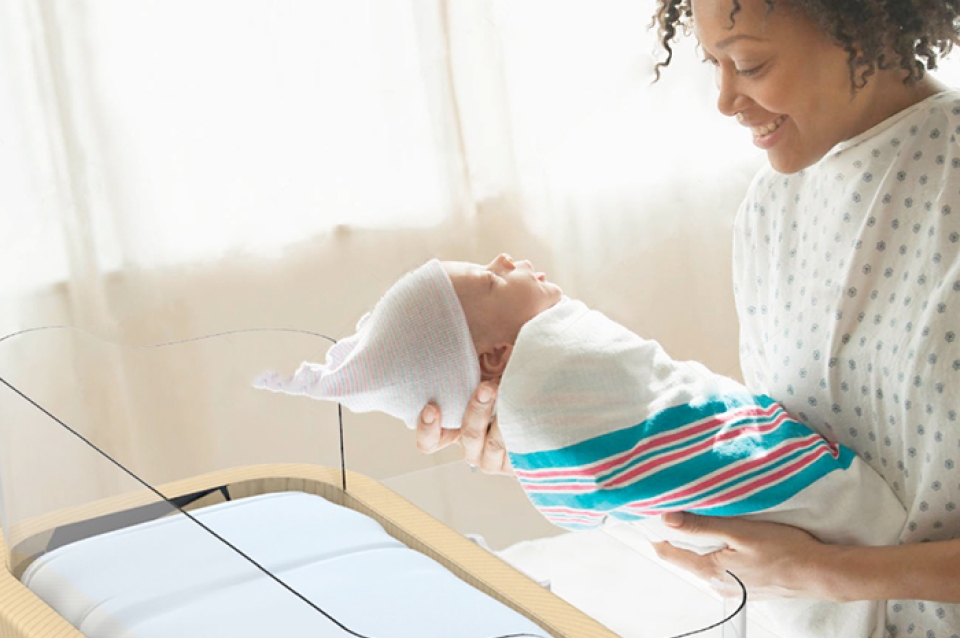June 27, 2016
Designing for Better Health Care Starts at Birth

A bedside crib designed by IPD students for Penn Medicine to reduce newborn falls. Photo: Xiaoye Zhang, Carissa Lim and Jessica Soe
Stuart Weitzman School of Design
102 Meyerson Hall
210 South 34th Street
Philadelphia, PA 19104

A bedside crib designed by IPD students for Penn Medicine to reduce newborn falls. Photo: Xiaoye Zhang, Carissa Lim and Jessica Soe
Michael Grant
mrgrant@design.upenn.edu
215.898.2539
Comprised of faculty from PennDesign, the School of Engineering and Applied Science, and The Wharton School, the Integrated Product Design (IPD) program is built on collaboration. Trained in technology, business, manufacturing, aesthetics and human-product interaction, students work in teams to create compelling new products and experiences.
But this spring IPD took collaboration a step further, partnering with Penn Medicine’s Center for Health Care Innovation—which is tasked with reimagining health care delivery for dramatically better value and patient outcomes—to help clinicians and administrators achieve better results at the Hospital of the University of Pennsylvania (HUP).
“I fundamentally believe that healthcare is a very important domain,” says IPD Associate Director Sarah Rottenberg. “There’s a huge need for improvement of systems, experiences and products in healthcare and better design can make a big impact there. I’d like for more of my students to be interested in designing for the field.” In the nine years since the program was launched, her efforts have already paid off: several graduates from IPD now work for the Center.
Over the spring semester, Rottenberg divided her class into six teams to tackle everything from better orchestrating patient flow on the oncology floor to devising a system to prevent cross-contamination of insulin pens. “Students work with doctors and nurses as well as patients, and for many this is the first time they’ve had a chance to interface with a real ‘client’,” says Rottenberg. “They learn client management, the importance of telling the story of their ideas, and how to really listen to feedback.” The goal, she adds, isn’t necessarily to create an actual product, but to leave the hospital with a good sense of direction for pursuing a solution to a specific problem.
First-year MIPD students Carissa Lim, Jessica Soe, and Xiaoye Zhang took on newborn falls, which typically occur in the middle of a night when a tired mother falls asleep while holding or breastfeeding her baby or has trouble transferring the infant to a crib. “It only happens a few times a year,” Lim says, “but obviously when it does it can be a very traumatic experience.”
To understand the issue, the students interviewed mothers, nurses, and support people such as the fathers of the newborns. Through their research, they learned that intangible obstacles—like mothers being reluctant to ‘bother’ nurses whenever they needed to and support people who were mystified about how they could help—often complicated the picture.
“They asked questions that we never thought to ask,” says Assistant Nurse Manager in Labor Delivery/Mother-Baby Laura Scalise, BSN, RNC. “Patients divulged information to them that they have never divulged to us.”
The students, in turn, heard the patients loud and clear. “My view of healthcare design has greatly evolved,” says Zhang. “At first I was focused on solving the problem. But after we interviewed the new mothers, their whole experience became important.” Soe adds, “When it came to ideation, the emotional needs led the iteration process.” Ease of use and layout of the room were also taken into account.
The students eventually came up with four ideas, including the “on-your-side” crib which, in the manner of a hospital tray, stays next to a mother’s bedside and can swing over her lap when she starts to feel tired, encouraging and easing the transition from mom-to-crib. “The nurses were extremely excited by it,” says Lim. “The one who came to our final crit even said that she’s going to pitch it to a manufacturer that HUP deals with.”
Other, more readily implementable, ideas were: wrapping call buttons in pink or blue stickers to remind new moms that a nurse is always at the ready to help, designing easy-to-read posters with clean graphics that show dads and other visitors how they can help overburdened moms, and installing “peep holes” on doors which allow nurses to quietly raise a shade to check on the room without needing to enter and leave it time and again during the night and early morning.
“We were all working together to turn the out the best of the best because, after all, if it doesn’t work for the user, what’s the point in designing it?” says Lim.